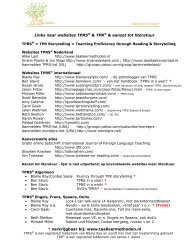TPRS in a Year - Taalleermethoden
TPRS in a Year - Taalleermethoden
TPRS in a Year - Taalleermethoden
Create successful ePaper yourself
Turn your PDF publications into a flip-book with our unique Google optimized e-Paper software.
m<strong>in</strong>ds of the students. They set up the tell<strong>in</strong>g of the story. They give the writtenwords on the board a sort of “auditory life” before the story.It makes sense! If you th<strong>in</strong>k about it, the structures aren’t easy for the kids. Theyhave never heard them before. They just saw them on the board, and they couldprobably use some practice hear<strong>in</strong>g them a little before you start the story! So thefirst step of <strong>TPRS</strong> activates the structures for the day.The second step of <strong>TPRS</strong> is ask<strong>in</strong>g the story. As you become more and morefamiliar with the method, you will develop a rapport with certa<strong>in</strong> of the skills listedbelow. Over time, you will use those skills to create your own k<strong>in</strong>d of storytell<strong>in</strong>g,a version that reflects your own personality and <strong>in</strong>terests.There is no one right way to establish mean<strong>in</strong>g (Step One) nor is there one right wayto ask a story (Step Two). Both steps are <strong>in</strong>terpreted by the <strong>in</strong>dividual teacher <strong>in</strong>their own way. The teacher accepts or rejects the various skills found <strong>in</strong> this book asrelevant and useful or not.When choos<strong>in</strong>g from the skills suggested <strong>in</strong> this book, ask yourself one question:Does this skill help me achieve comprehensible <strong>in</strong>put (CI) and personalization (P)?Comprehensible <strong>in</strong>put and personalization are the two pillars on which all <strong>TPRS</strong>classes f<strong>in</strong>d an unshakable foundation.In fact, accord<strong>in</strong>g to some <strong>TPRS</strong> experts, CI and P are the only requirements foracquisition to occur. If a skill does not help you achieve comprehensible <strong>in</strong>put andpersonalization, it is probably worth skipp<strong>in</strong>g, or exam<strong>in</strong><strong>in</strong>g later.Try<strong>in</strong>g to learn too many skills too fast is to not see the forest for the trees, andshould be avoided. The forest (CI + P) is vast and rich enough by itself.Preoccupation with any one tree (skill) or group of trees is not that important.What is the nature of this forest we are describ<strong>in</strong>g as comprehensible <strong>in</strong>put pluspersonalization? It is simple. With comprehensible <strong>in</strong>put we reach <strong>in</strong>to our students‟m<strong>in</strong>ds; with personalization we connect with their hearts. Both are necessary forsuccess.When we provide CI, but fail to assure that its content reflect the <strong>in</strong>dividual needsand personalities of the students, we fail. On the other hand, any classroom thatdoes not <strong>in</strong>clude massive and daily amounts of comprehensible <strong>in</strong>put will fail aswell. Only with both CI and P can we achieve a m<strong>in</strong>d/heart balance <strong>in</strong> ourclassrooms and supercharge our students capacity to authentically acquire the targetlanguage.The skills <strong>in</strong> <strong>TPRS</strong> <strong>in</strong> a <strong>Year</strong>! are grouped <strong>in</strong>to three areas, which offer a work<strong>in</strong>gbluepr<strong>in</strong>t for the novice <strong>TPRS</strong> <strong>in</strong>structor:



